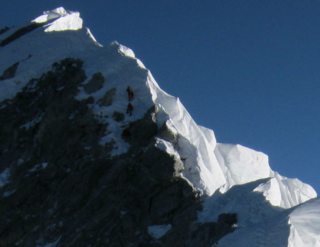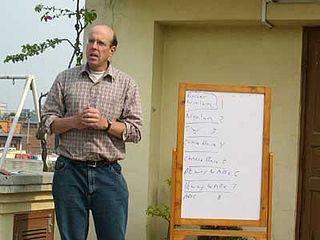
Sir Edmund Percival Hillary was a New Zealand mountaineer, explorer, and philanthropist. On 29 May 1953, Hillary and Sherpa mountaineer Tenzing Norgay became the first climbers confirmed to have reached the summit of Mount Everest. They were part of the ninth British expedition to Everest, led by John Hunt. From 1985 to 1988 he served as New Zealand's High Commissioner to India and Bangladesh and concurrently as Ambassador to Nepal.

George Herbert Leigh-Mallory was an English mountaineer who participated in the first three British Mount Everest expeditions in the early 1920s. He and climbing partner Andrew "Sandy" Irvine were last seen ascending near Everest's summit during the 1924 expedition, sparking debate as to whether they reached it before they died.

Andrew Comyn "Sandy" Irvine was a British mountaineer who took part in the 1924 British Mount Everest expedition, the third British expedition to the world's highest mountain, Mount Everest.

Changtse is a mountain situated between the Main Rongbuk and East Rongbuk Glaciers in Tibet Autonomous Region, China, immediately north of Mount Everest. It is connected to Mount Everest via the North Col.
The Oxford University Mountaineering Club (OUMC) was founded in 1909 by Arnold Lunn, then a Balliol undergraduate; he did not earn a degree.

Noel Ewart Odell FRSE FGS was an English geologist and mountaineer. In 1924 he was an oxygen officer on the Everest expedition in which George Mallory and Andrew Irvine famously perished during their summit attempt. Odell spent two weeks living above 23,000 feet (7,000 m), and twice climbed to 26,800 feet (8,200 m) and higher, all without supplemental oxygen. In 1936 Noel Odell with Bill Tilman climbed Nanda Devi, at the time the highest mountain climbed.

The North Col refers to the sharp-edged pass carved by glaciers in the ridge connecting Mount Everest and Changtse in Tibet. It forms the head of the East Rongbuk Glacier.

The Hillary Step was a 40-foot vertical rock face that sits 8,790 metres (28,839 ft) above sea level. It was located near the summit of Mount Everest. Located on the Southeast ridge, halfway between the "South Summit" and the True Summit, the Hillary Step was the most technically difficult part of the typical Nepal-side Everest climb and the last real challenge before reaching the top of the mountain. The rock face was destroyed by an earthquake that struck the region in 2015.

Daniel Lee Mazur is a mountain climber, expedition leader, and philanthropist who has ascended nine of the world's highest summits, including Mount Everest and K2. He is also known for several high altitude mountain rescues: the 1991 rescue of Roman Giutashvili from Mount Everest, the rescue of Gary Ball from K2 in 1992, the rescue in 2006 of Australian climber Lincoln Hall from Mount Everest, and the rescue of British mountaineer Rick Allen from Broad Peak in 2018.

Peter Edmund Hillary is a New Zealand mountaineer and philanthropist. He is the son of Sir Edmund Hillary, who, along with mountaineer Tenzing Norgay, completed the first successful ascent of Mount Everest. When Peter Hillary summited Everest in 1990, he and his father were the first father/son duo to achieve the feat. Hillary has achieved two summits of Everest, an 84-day trek across Antarctica to the South Pole, and an expedition guiding astronaut Neil Armstrong to land a small aircraft at the North Pole. He has climbed many of the world's major peaks, and on 19 June 2008, completed the Seven Summits, reaching the top of the highest mountains on all seven continents, when he summited Denali in Alaska.
The Mount Everest Committee was a body formed by the Alpine Club and the Royal Geographical Society to co-ordinate and finance the 1921 British Mount Everest reconnaissance expedition to Mount Everest and all subsequent British expeditions to climb the mountain until 1947. It was then renamed the Joint Himalayan Committee; this latter committee organised and financed the successful first ascent of Mount Everest in 1953.

Cuthbert Wilfrid Francis Noyce was an English mountaineer and author. He was a member of the 1953 British Expedition that made the first ascent of Mount Everest.

The 1924 British Mount Everest expedition was—after the 1922 British Mount Everest expedition—the 2nd expedition with the goal of achieving the first ascent of Mount Everest. After two summit attempts in which Edward Norton set a world altitude record of 8,572.8 metres (28,126 ft), the mountaineers George Mallory and Andrew "Sandy" Irvine disappeared on the third attempt. Their disappearance has given rise to the long-standing speculation of whether or not the pair might – under a narrow set of assumptions – have reached the summit. Mallory's body was found in 1999 at 8,156 metres (26,760 ft), but the resulting clues did not provide any conclusive evidence as to whether the summit was reached. Irvine's partial remains were later found in 2024 by a National Geographic team during a descent of the Rongbuk Glacier by the north face.

The 1922 British Mount Everest expedition was the first mountaineering expedition with the express aim of making the first ascent of Mount Everest. It was also the first expedition that used bottled oxygen while climbing Everest. The attempt was made from the northern side of Everest out of Tibet. At the time, Everest could not be attempted from the south out of Nepal as the country was closed to Western foreigners.

The 1953 British Mount Everest expedition was the ninth mountaineering expedition to attempt the first ascent of Mount Everest, and the first confirmed to have succeeded when Tenzing Norgay and Edmund Hillary reached the summit on 29 May 1953. Led by Colonel John Hunt, it was organised and financed by the Joint Himalayan Committee. News of the expedition's success reached London in time to be released on the morning of Queen Elizabeth II's coronation, on 2 June that year.

Guy Henry Bullock was a British diplomat who is best known for his participation in the 1921 British Mount Everest reconnaissance expedition. As expedition mountaineers, he and George Mallory found a northern access route to Everest by climbing the 6,849-metre (22,470 ft) Lhakpa La col above the East Rongbuk Glacier and by going on to reach the North Col at 7,020 metres (23,030 ft). They did not, however, reach the summit of Mount Everest.

Major General John Geoffrey Bruce was an officer in the British Indian Army, eventually becoming Deputy Chief of General Staff, who participated in the 1922 British Mount Everest expedition. Bruce, who had never before climbed a mountain, had been appointed as a transport officer, but chance led to him accompanying George Finch on the only summit attempt that used supplemental oxygen. Together they set a new mountaineering world record height of 27,300 ft (8,321 m), only 1,731.7 ft (527.82 m) below the summit of Mount Everest. He also took part in the 1924 British Mount Everest expedition, and for a time was slated to make the first summit attempt with George Mallory, before the party was forced to retreat and Mallory subsequently went for the top with Sandy Irvine.
The 1936 British Mount Everest expedition was a complete failure, and raised questions concerning the planning of such expeditions. This was Hugh Ruttledge's second expedition as leader. Heavy snows and an early monsoon forced their retreat on several occasions, and on the final attempt two climbers narrowly survived an avalanche. This was the first expedition in which climbers were able to carry portable radios.

Hugh Thackeray Turner was an English Arts and Crafts architect and also an amateur china painter.
The following is a list of unproduced Doug Liman projects in roughly chronological order. During his long career, American filmmaker Doug Liman has worked on several projects which never progressed beyond the pre-production stage under his direction. Some of these projects fell in development hell, were officially canceled, were in development limbo or would see life under a different production team.

















